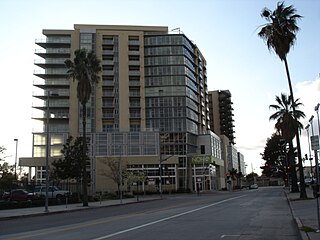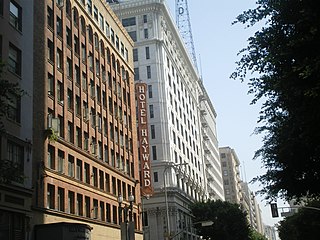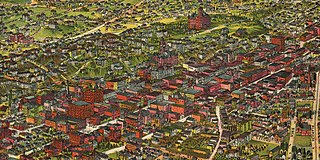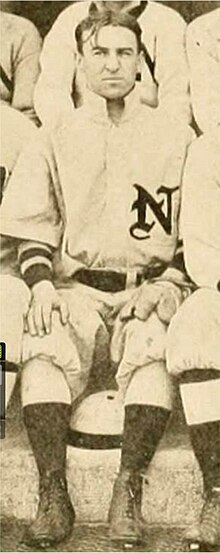
The NoHo Arts District is a community in North Hollywood, Los Angeles, California, that is home to contemporary theaters, art galleries, cafes, and shops. The community is generally bounded by Hatteras Street to the north, Cahuenga Blvd to the east, Tujunga Ave to the west, and Camarillo Street to the south. The area features more than twenty professional theaters, producing new work and classics, diverse art galleries, public art, and professional dance studios. The district also features the largest concentration of music recording venues west of the Mississippi. A Metro Rail station is located here, the North Hollywood station of the B Line and serves as the terminus of the Metro G Line busway.

Broadway, until 1890 Fort Street, is a thoroughfare in Los Angeles County, California, United States. The portion of Broadway from 3rd to 9th streets, in the Historic Core of Downtown Los Angeles, was the city's main commercial street from the 1910s until World War II, and is the location of the Broadway Theater and Commercial District, the first and largest historic theater district listed on the National Register of Historic Places (NRHP). With twelve movie palaces located along a six-block stretch of Broadway, it is the only large concentration of movie palaces left in the United States.

May Company California was an American chain of department stores operating in Southern California and Nevada, with headquarters at its flagship Downtown Los Angeles store until 1983 when it moved them to North Hollywood. It was a subsidiary of May Department Stores and merged with May's other Southern California subsidiary, J. W. Robinson's, in 1993 to form Robinsons-May.
The Studebaker Building is a former structure at 1600 Broadway on the northeast corner at 48th Street in Manhattan, New York City. It was erected by the Juilliard Estate, in 1902, between Broadway and 7th Avenue, in the area north of Times Square. It was demolished in 2004 to make room for an apartment tower, a twenty- five story, 136 unit, luxury condominium designed by architect Einhorn Yaffee Prescott.

The San Fernando Building is an Italian Renaissance Revival style building built in 1906 on Main Street in the Historic Core district of downtown Los Angeles, California. It was listed in the National Register of Historic Places in 1986, converted into lofts in 2000, and declared a Historic-Cultural Monument in 2002.

Spring Street in Los Angeles is one of the oldest streets in the city. Along Spring Street in Downtown Los Angeles, from just north of Fourth Street to just south of Seventh Street is the NRHP-listed Spring Street Financial District, nicknamed Wall Street of the West, lined with Beaux Arts buildings and currently experiencing gentrification. This section forms part of the Historic Core district of Downtown, together with portions of Hill, Broadway, Main and Los Angeles streets.

Morgan, Walls & Clements was an architectural firm based in Los Angeles, California and responsible for many of the city's landmarks, dating back to the late 19th century. Originally Morgan and Walls, with principals Octavius Morgan and John A. Walls, the firm worked in the area from before the turn of the century.

William Hayes Perry (1832–1906) was a 19th-century lumber merchant and financier in Los Angeles. He was known as "a masterful man whose influence and backing has been felt for fifty years in the development of Southern California."

James Boon Lankershim was an American heir, landowner and real estate developer.

The Blackstone Building is a 1916 structure located at 901 South Broadway in Los Angeles, California. It has been listed as a Los Angeles Historic-Cultural Monument since 2003. The Blackstone Department Store Building is an early example of the work of John B. Parkinson, Los Angeles’ preeminent architect of the early 20th century, who also designed Bullocks Wilshire. The building is clad in gray terra cotta and styled in the Beaux Arts school.

The May Company Building on Broadway in Downtown Los Angeles, a.k.a. Hamburgers/May Company Department Store and the May Department Store Building, later known as the California Broadway Trade Center, was the flagship store of the May Company California department store chain. It is a contributing property to the NRHP-listed Broadway Theater and Commercial District.

Robert Brown Young was a Canadian-born architect who designed buildings in California.

Harry Lehrer was an American licensed pharmacist, physician, and real estate speculator who owned the Bumiller Building in Los Angeles.
Le Bon Marché is a French department store.

Coulter's was a department store that originated in Downtown Los Angeles and later moved to the Miracle Mile shopping district in that same city.

The late-Victorian-era Downtown of Los Angeles in 1880 was centered at the southern end of the Los Angeles Plaza area, and over the next two decades, it extended south and west along Main Street, Spring Street, and Broadway towards Third Street. Most of the 19th-century buildings no longer exist, surviving only in the Plaza area or south of Second Street. The rest were demolished to make way for the Civic Center district with City Hall, numerous courthouses, and other municipal, county, state and federal buildings, and Times Mirror Square. This article covers that area, between the Plaza, 3rd St., Los Angeles St., and Broadway, during the period 1880 through the period of demolition (1920s–1950s).

Jacoby Bros. was one of Los Angeles' largest dry goods retailers in the 1880s and 1890s, developing over the decades into a department store, which closed in the late 1930s.

7th Street is a street in Los Angeles, California running from S. Norton Ave in Mid-Wilshire through Downtown Los Angeles. It goes all the way to the eastern city limits at Indiana Ave., and the border between Boyle Heights, Los Angeles and East Los Angeles.

Retail in Southern California dates back to its first dry goods store that Jonathan Temple opened in 1827 on Calle Principal, when Los Angeles was still a Mexican village. After the American conquest, as the pueblo grew into a small town surpassing 4,000 population in 1860, dry goods stores continued to open, including the forerunners of what would be local chains. Larger retailers moved progressively further south to the 1880s-1890s Central Business District, which was later razed to become the Civic Center. Starting in the mid-1890s, major stores moved ever southward, first onto Broadway around 3rd, then starting in 1905 to Broadway between 4th and 9th, then starting in 1915 westward onto West Seventh Street up to Figueroa. For half a century Broadway and Seventh streets together formed one of America's largest and busiest downtown shopping districts.



















